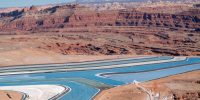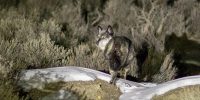LightHawk flew for conservation in so many ways this summer!
An orchard under an agricultural conservation easement is hugged by Colorado’s Gunnison River. In a drought year riddled with wildfires, aerial monitoring of conservation lands reduces the risk of sparking a fire and the dangers that follow. Jeremy Puckett/CWLT
Smokey Bear is Proud of Us!
LightHawk Helps Fire-Ravaged West
Colorado shared a disastrous fate with many Western states this year. Many were ravaged by wildfires this year, and 2018 is one of the worst fire years on record for the state. While wildfire is a natural and necessary event in nature, the risk to human lives is undeniable. LightHawk and Colorado West Land Trust, a partnership of Black Canyon Regional and Mesa Land Trusts, monitored conservation easement lands while avoiding setting any sparks on this parched country. From high above, LightHawk flights allowed Land Trust staff to safely observe 70 easements covering over 30,000 acres. These four hours of flights kept fire-sparking trucks off remote, drought-stricken conservation easements, while simultaneously saving the Land Trust 380 hours of staff time, and $15,000!
With your support, we provide land trusts the best tool — aviation — to monitor conservation-friendly properties around the U.S. By saving Colorado West Land Trust both staff time and funds, they can conserve more Colorado ranches, orchards, and key landscapes for conservation. Because LightHawk flies for land trusts, more land is conserved.
Our Most Adorable Species Survival Passenger of 2018
International Effort to Protect Otters
Otters, and most other wildlife, can’t get a ticket on a commercial airline. Kate the River Otter was in need of a new home at the Calgary Zoo, but her options for getting there from Chicago’s Brookfield Zoo were limited. There were no direct commercial flights willing to transport her. The only commercial flights available required an overnight stay in Toronto. Considering all the stressful sights and sounds in a cargo hold, Kate’s welfare would be at stake. Alternatively, a drive to her new home would take 25 hours!
That’s where LightHawk came to the rescue! Kate the Otter flew with LightHawk Volunteer Pilot, Chuck Yanke, and made the trip from Chicago to Calgary in his (very fast) Pilatus PC-12 in just five hours. We coordinated this flight to make it as stress-free as possible. Now she is in her new home, with her new mate, and she is a critical member of the North American River Otter Species Survival Plan. Her genes will help maintain a healthy and self-sustaining population of these playful animals.
We delivered Kate to her new habitat in the fastest, most comfortable way possible and we couldn’t have done it without your help.

Food or Fuel?
LightHawk Flights Bring Scope to Fracking Development
LightHawk’s perspective is unparalleled. There’s nothing quite like a LightHawk flight to show decision makers and journalists an industry’s impact on the land. Dr. Ted Auch, Great Lakes Program Coordinator for FrackTracker Alliance and a leading resource on oil and gas issues, took a series of flights this year to document fracking industry activities in Illinois, and share the aerial perspective with local investors, Northwestern University law professors, county officials and press outlets.
“The bird’s-eye-view allows you to see the grandeur and nuance of all things beautiful and humbling. Conversely…[a] Cessna allows one to really absorb the extent, degree, and intensity of all things destructive,” notes Dr. Auch.
The fracking sand mines the passengers saw are in one of the nation’s most productive agricultural areas, known for producing record amounts of soybeans and corn. As fracking industry activity increases in America’s breadbasket, we may be risking our future food security.
Your support allows us to spring into action to inform key constituents about the impacts of the fracking industry, allowing for more informed debate on resource production.

400 Reasons to Preserve New Jersey Shores
Sanctuary Creates Larger Home for Migrating Birds
Cape May National Wildlife Refuge, on the southern tip of New Jersey, is a coastal haven for birds migrating along the heavily developed east coast. Over 400 species call the refuge home, and they’re increasingly threatened as the Jersey Shore habitat changes from marsh and forest to shopping malls and beach houses. The refuge is an internationally recognized Important Bird Area, and draws birders from around the world to see the hundreds of thousands that migrate through each year. Not only protecting wildlife, the refuge’s natural landscapes lessen the impacts of storms and rising sea levels for people that call the peninsula home.
Working with our longtime partner, The Nature Conservancy of New Jersey, an additional 477 acres of private property were purchased and gifted to the Cape May National Wildlife Refuge. This was the largest privately owned natural property remaining on the peninsula. A deal over a decade in the making, LightHawk flew journalists to create stories that changed hearts and minds to deliver this win for conservation.
Because of your support, we are expanding critical habitat for wildlife, protecting against rising sea levels, and providing new recreational outdoor opportunities for urban citizens.
One People, One Planet
We share 96% of our human DNA with Chimpanzees, and interestingly, more than 50% with hens, house flies, and bananas. We are more similar than dissimilar to much of life on our planet. Perhaps that’s why we feel more connected to the earth and the universe when we’re hiking in the woods, or driving over a mountain pass. Those feelings of connectedness are magnified by the awe we feel when seeing the earth from the windows of a small plane. Awe leads to change, and reconnects us to the fabric of all living things.
So thank you for being connected to our planet — and to LightHawk. And thank you for making the successes described on these pages a reality. We deeply appreciate your support.
Warmest regards,Bob FrancellaChief Advancement Oficer
To view this in a PDF click HERE.


